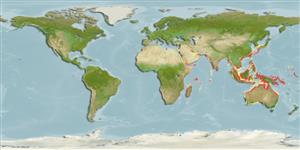Common names from other countries
Environment: milieu / climate zone / depth range / distribution range
Ecology
Marine; demersal; amphidromous (Ref. 51243); depth range 22 - 38 m (Ref. 11790). Tropical
Indo-West Pacific: Persian Gulf and off India (from Bombay southward to Sri Lanka) eastward to western New Guinea and southern China (Ref. 9774).
Size / Weight / Age
Maturity: Lm ? range ? - ? cm
Max length : 35.0 cm SL male/unsexed; (Ref. 9774); common length : 20.0 cm SL male/unsexed; (Ref. 9774)
Dorsal spines (total): 0; Dorsal soft rays (total): 67 - 76; Anal spines: 0; Anal soft rays: 51 - 56. Body brownish, a distinct, large dark blotch at junction of straight and curved parts of lateral line and a smaller blotch on middle of straight section of lateral line, many dark rings scattered on body. Upper profile of head without notch in front of eye. Scales on eyed side ctenoid on anterior part and dorsal and ventral margins of body on eyed side, cycloid on remaining areas. Pectoral fin on ocular side with 11-12 soft rays (Ref 9774).
Inhabits shallow continental shelves with muddy and sandy substrates. Feeds on benthic animals. Marketed mostly fresh.
Life cycle and mating behavior
Maturities | Reproduction | Spawnings | Egg(s) | Fecundities | Larvae
Distinct pairing (Ref. 205).
Nielsen, J.G., 1984. Bothidae. In W. Fischer and G. Bianchi (eds.) FAO species identification sheets for fishery purposes. Western Indian Ocean fishing area 51. Vol. 1. FAO, Rome. pag. var. (Ref. 3322)
IUCN Red List Status (Ref. 130435)
CITES (Ref. 128078)
Not Evaluated
Threat to humans
Harmless
Human uses
Fisheries: commercial
Tools
Special reports
Download XML
Internet sources
Estimates based on models
Preferred temperature (Ref.
115969): 23.8 - 28.8, mean 28 (based on 226 cells).
Phylogenetic diversity index (Ref.
82804): PD
50 = 0.5000 [Uniqueness, from 0.5 = low to 2.0 = high].
Bayesian length-weight: a=0.00741 (0.00343 - 0.01604), b=3.17 (3.00 - 3.34), in cm Total Length, based on LWR estimates for this Genus-body shape (Ref.
93245).
Trophic level (Ref.
69278): 3.5 ±0.37 se; based on food items.
Resilience (Ref.
120179): High, minimum population doubling time less than 15 months (Preliminary K or Fecundity.).
Fishing Vulnerability (Ref.
59153): Low vulnerability (20 of 100).
